With nearly 500 years of history, the Holy Cathedral Church of Mérida, dedicated to Saint Ildefonsus of Toledo, is one of the most iconic landmarks of the city—and possibly of the entire state of Yucatán.
What exactly makes it so iconic? It might well be its monumentality. Setting aside its 40-meter (131 ft) wide façade, let’s talk about its height: inside, the vaulted ceilings soar over 22 meters (72 ft) high. On the outside, its towers rise 43.5 meters (143 ft) into the sky. Even today, in the 21st century, it’s an awe-inspiring sight. Now imagine seeing it back when it was built, between 1561 and 1598. At that point, neither Don Quixote nor most of William Shakespeare’s works had been written. Many of the Maya alive at the time had survived a bloody war against people unlike anyone they had ever encountered before; many still remembered life before the arrival of the conquistadors. The cathedral was imposing and unlike anything that had ever been built on this land.
But beyond its size, it is its features, and in many ways, its history that make it truly unique.
The peculiar appearance of the Cathedral of Mérida
Just about any Yucateco can tell you that the Cathedral of Mérida was the first Catholic church built on the mainland of the American continent; the second, if you count the one built a few years earlier on the island of Santo Domingo. But let us tell you about some other interesting details you can observe in it.
Was the Cathedral built using the wrong blueprints?
There’s a persistent myth that Mérida was too small a settlement for such a massive church, and that the Cathedral of Saint Ildefonsus was built using plans originally intended for another city. But this is only a myth. Mérida, and all of Yucatán, was already recognized for its strategic importance to the Spanish expansion. Other churches and the large (and numerous) convents like Saint Bernardino of Siena in Valladolid, Saint Anthony of Padua in Izamal, and Saint Francis of Assisi in Conkal are proof of that.
The Cathedral of Saint Ildefonsus in Mérida is part of a specific architectural movement from the early years of the Spanish Conquest, though with some particularly unique features of its own.
For instance, look at its form—clean and monumental. Straight lines and cubic shapes dominate, yet the façade also incorporates what could be interpreted as a massive “triumphal arch.” With its architectural elements set at different depths, the play of light and shadow adds contrast—and therefore, visual impact.
Also, note how the straight lines and flat surfaces evoke the shape of a fortress. Considering the challenges the Spanish faced in conquering Yucatán, it’s only natural that they would want to build something imposing—something that communicated to the Maya not only the power and permanence of the “true God,” but also the new era that was beginning. It’s not far-fetched to think that, in case of future uprisings, the structure could also be used quite literally as a stronghold for the Spanish.
Elements of the façade of the Cathedral of Mérida
There are no official guided tours of the Holy Cathedral Church in Mérida, but that doesn’t mean you can’t appreciate some of its features from a distance.
The façade of the Cathedral of Mérida has three doors. The central one is called the Gate of Forgiveness, and it is only opened on special occasions. This door is flanked by statues of Saint Peter and Saint Paul, the only religious figures carved into the building itself.
Now let’s take a look at the different openings on the façade. At the center, just above the Gate of Forgiveness, is the largest one: this is the choir window. The next openings are located a bit higher up, in the towers near the corners: these are the windows of the bell ringers’ quarters.
Speaking of bell ringers…
For centuries, the cathedral had an official bell ringer. He had his own room, measuring about 4.5 meters (15 ft) long by 2.5 meters (8 ft) wide, which included a hammock holder, a candle, and a small organ. His job was to climb up and ring the large bells half an hour before every Mass. In those days, there was Mass almost every hour, so the bell ringer needed to be both committed, and have a good pair of legs.
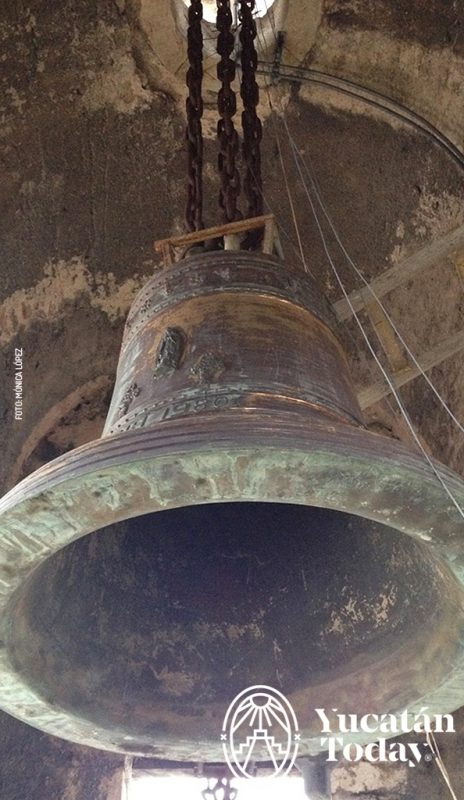 The bells of the Cathedral (which are still in use) are located in the north tower (that is, to your left if you’re facing the church). The tower houses ten bells in total, each one dedicated to a different saint; five of them are relatively new, installed and blessed in 1980. The oldest dates back to colonial times: dedicated to Saint Mary and Saint Ildefonsus, it was cast in 1618. You can see some of the old bells yourself: when they were replaced, several were left on display in the cathedral’s courtyard. You can read more about the Cathedral’s bells in this article in Spanish published by Diario de Yucatán in 2020.
The bells of the Cathedral (which are still in use) are located in the north tower (that is, to your left if you’re facing the church). The tower houses ten bells in total, each one dedicated to a different saint; five of them are relatively new, installed and blessed in 1980. The oldest dates back to colonial times: dedicated to Saint Mary and Saint Ildefonsus, it was cast in 1618. You can see some of the old bells yourself: when they were replaced, several were left on display in the cathedral’s courtyard. You can read more about the Cathedral’s bells in this article in Spanish published by Diario de Yucatán in 2020.
Now, you might think both towers of the Cathedral serve as bell towers. But take a closer look: on the south tower (on your right), above the bell ringer’s window, where the bells should be, there’s a small balcony and a yellow square. This was once one of Mérida’s public clocks. The mechanical clock was made in London in 1731 and stopped working in 1871. If you’ve got sharp eyes (or a camera with good zoom and decent sunlight), try looking at the next level of the tower: arranged around the arch, you might be able to make out the Roman numerals that once marked the Cathedral’s now-defunct sundial.
At the corners of each level of both towers, you’ll see decorative geometric finials: a pyramid resting on a sphere, which in turn sits on a square base. But if you look closely at the ones on the middle tier, you’ll notice that instead of those small obelisks, the finials are shaped like stone bells.
Arrowslits of Mérida’s Cathedral
¿Recuerdas que la Catedral de San Ildefonso estaba pensada para fungir también como una fortaleza defensiva? Esto se hace especialmente evidente si observas que, sobre todo el cuerpo de la construcción hay varias hileras de “rendijas” verticales en la piedra. Éstas son aspilleras: aberturas defensivas, diseñadas para disparar hacia el exterior, minimizando el riesgo hacia el interior. Éstas están dispuestas a lo largo de diversas áreas que los españoles seguramente consideraron estratégicas en caso de enfrentamientos.
The curious history of the coat of arms of Mérida’s Cathedral
The most striking and ornamental feature of the Cathedral of San Ildefonso is, without a doubt, its massive coat of arms carved in stone, framed by the triumphal arch in the center of the façade.
At a glance, it’s clear that this is a coat of arms. Much of it is original, except for the central part. In 1599, it bore the coat of arms of King Philip III; though that specific emblem was later replaced, the surrounding decorations survive to this day, including the following inscriptions on either side near the bottom:
PHILIP III D.G. HISPANIARVM ET YNDIARVM REX.
Philip III, by the grace of God, King of Spain and the Indies
ANNO A NATIVITATE DOMINI 1599
In the Year of Our Lord 1599
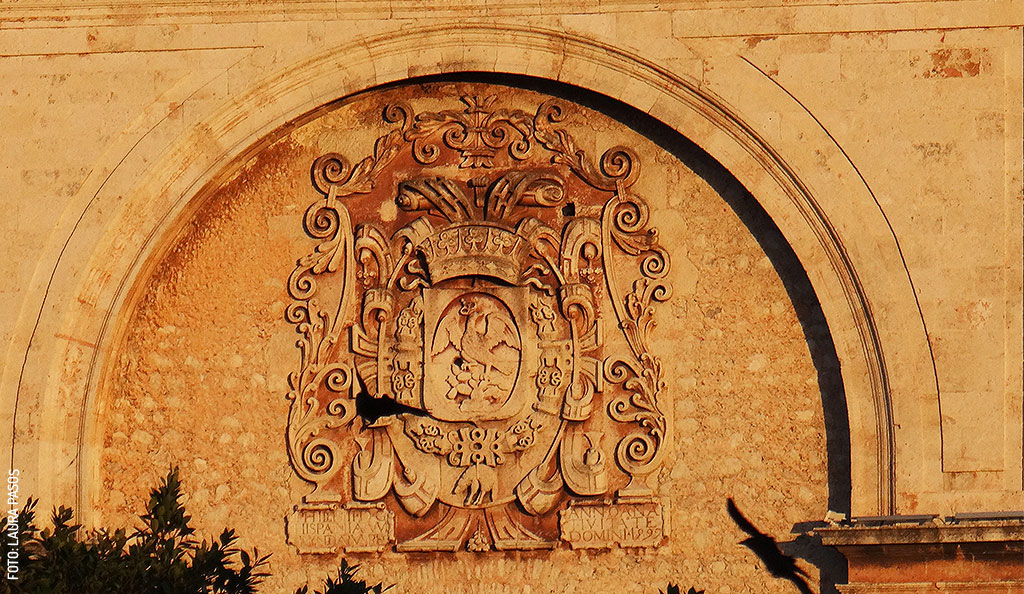
In addition to the usual heraldic motifs like scrolls and foliage, the coat of arms includes a royal crown and one very curious detail: at the center, seemingly “hanging” from the main shield, is a little lamb. This references the Illustrious Order of the Golden Fleece, one of Europe’s oldest, most prestigious, and exclusive orders of knighthood, whose Grand Master has always been the Spanish monarch.
Now, let’s take a closer look at the coat of arms. In 1822, once México achieved independence, the coat of arms of Philip III was chiseled off. In its place, they installed the emblem of then-Emperor Agustín de Iturbide. This new crest was an early version of what would become the modern Mexican coat of arms: a golden eagle perched on a nopal cactus. At the time, the serpent was not yet included, and the eagle, facing right instead of today’s left, wore a crown referencing the short-lived Mexican Empire.
The First Mexican Empire didn’t last long. Once México reverted to a republic, the eagle’s crown was covered with mortar (a mix of lime, water, and sand). Soon after, the entire coat of arms was concealed. Thus, the cathedral’s coat of arms remained hidden from 1826 to 1865.
What happened in 1865? That year saw the height of the Second Mexican Empire, led by Maximilian of Habsburg, who was tricked into coming from Austria to serve as emperor. In November of that year, his wife, Empress Charlotte, visited Yucatán (Sisal, Mérida, Campeche, and Ciudad del Carmen, the areas least affected by the ongoing Caste War). By the time of her visit, the mortar had been removed, and the imperial crest was once again visible.
The Second Mexican Empire also didn’t last long. In 1867, the forces loyal to Benito Juárez had restored the Mexican Republic. Mérida’s Cathedral coat of arms was covered once again.
The version of the cathedral’s coat of arms we see today was last revealed sometime after President Porfirio Díaz visited Yucatán in 1906.
One very curious fact about Mérida’s Cathedral that you might not notice at first glance: how many crosses are visible on its façade? The answer is…none.
The city’s chronicler, Gonzalo Navarrete Muñoz, suggests that this may be due to the fact that the Conquest of Yucatán took place during the Catholic Counter-Reformation. The Protestant Reformation, started by Martin Luther in 1517, rejected the role of saints (including the Virgin Mary) as intercessors between humans and God, and also their veneration. The Counter-Reformation was the Catholic Church’s response, aimed at revitalizing its authority, reinforcing papal power, and reaffirming the importance of saints and various Marian devotions. Curiously, none of the churches built in Mérida during that time are dedicated to Jesus Christ, with the sole exception of the Jesuit Church of the Third Order.
The interior of the Cathedral of San Ildefonso of Mérida
Inside, the Cathedral of Mérida is perhaps even more austere than on the outside, yet equally monumental. Observe the massive stone columns, the central vaulted ceiling, and its ribs. Be sure to look up at the dome, which replicates the structure of the Pantheon in Rome.
The cathedral has three naves: a central nave and two lateral ones (the Gospel Nave and the Epistle Nave). Up until the early 20th century, it featured five chapels, in addition to the Sacristy. The three chapels located to the north still exist; they house the Baptistery, the Tabernacle, and the Christ of the Blisters.
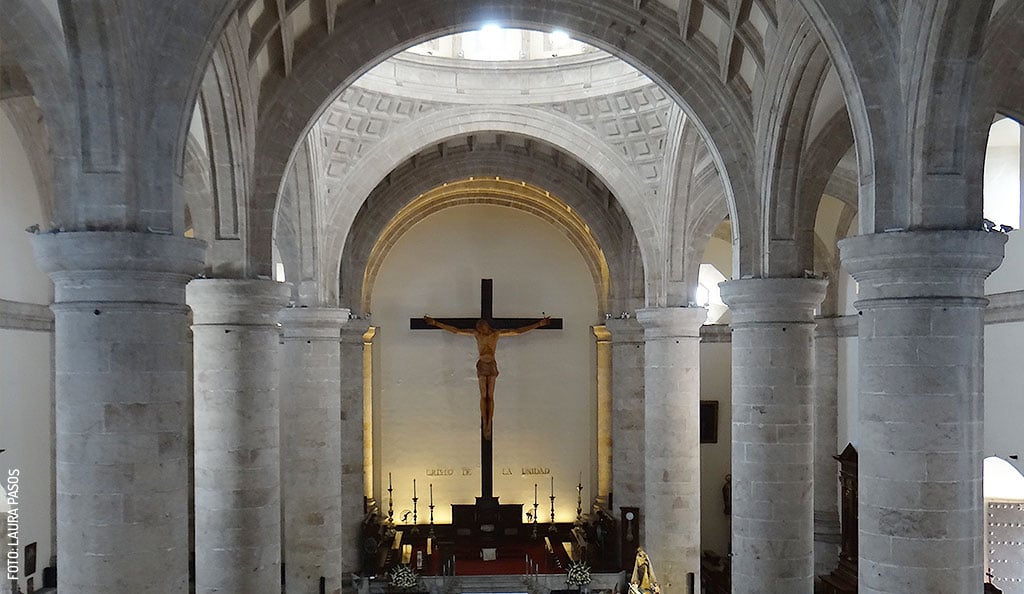
The Christ of the Blisters
The image known as The Christ of the Blisters has been surrounded by legends for centuries. The first written account of its origin dates back to 1887, when historian Crescencio Carrillo y Ancona recorded oral traditions. According to the story, in the 1620s, in the village of Ichmul (near Peto), a tree glowed for several weeks as if it were on fire. Intending to turn it into a religious image, the village priest had the tree cut down, and, by a stroke of luck, a man who had just arrived in the village offered to carve it.
Although the supposed woodcarver had no tools, the priest asked him for an image of the Virgin of the Immaculate Conception and left him with the wood, noting that the man seemed unprepared to begin working. To his surprise, the next day, the carver had vanished and left behind an image of Christ in the workshop. Word quickly spread that the new Christ figure in the church had been crafted by an angel. The Christ turned out to be very miraculous, healing the sick and granting favors, but it truly rose to fame in 1651, when the church of Ichmul burned down completely. Nothing remained—except, among the ashes, the wooden Christ; instead of being consumed by the flames as expected, it turned black, with markings on its surface resembling the wounds Jesus of Nazareth is said to have suffered during the Passion.
From then on, it became known as The Christ of the Blisters. Shortly after, it was moved to the Cathedral of Mérida so more people could venerate it. It remained one of Yucatán's most important religious icons for centuries. However, the current figure on display is a replica made in 1919; the original was lost forever during a looting in 1915.
1915: The looting of the Cathedral of San Ildefonso
Historical context: The Mexican Revolution in Yucatán
The Mexican Revolution (starting in 1910) brought deep instability to the country, and historians still debate when it officially ended. Although it began as an uprising against the government of Porfirio Díaz (which had lasted for over 30 years), the conflict soon evolved into multiple civil wars led by factions each pursuing their vision of revolutionary ideals.
It was within this turbulent era that General Salvador Alvarado, from Sinaloa, arrived in Yucatán to implement revolutionary reforms. These included curbing the power of the Church and, specifically, its priests. Although Alvarado later became known alongside Felipe Carrillo Puerto as a champion of the indigenous Maya and agrarian communities, his rule was marked by controversy.
![San-Ildefonso-catedral-de-Merida-escaleras-techo-arco-by-Laura-Pasos]() The cathedral’s destruction
The cathedral’s destruction
In September 1915, a union-led rally approached the Government Palace, but when they reached the Cathedral, speakers urged the crowd to "destroy religious exaltation forever" and "burn the idols of fanatic Catholics today."
Riled up, the protestors broke down the Cathedral’s door. Once inside, they destroyed the altarpiece (crafted in 1762 from wood and gold leaf) along with the images it held—many of which were even older, including that of Saint Ildephonsus. It is said, in fact, that they attempted to burn the Christ of the Blisters, but that, once again, it did not catch fire. Nevertheless, the image was stolen and never recovered. The furnishings, including the pulpit and even the organ (which had been brought from Germany in 1902), were completely destroyed. The two chapels located on the southern side (which connected the Cathedral with what was then the Episcopal Palace, residence of the archbishop) were demolished. In their place, a pedestrian walkway called Pasaje Revolución was built.
The destruction was so great that Salvador Alvarado's government confiscated both buildings. The Episcopal Palace was renamed "Palacio Ateneo" and turned into a public cultural center. As for the Cathedral, it was used as a henequén warehouse until 1917.
Restoration of the Holy Metropolitan Cathedral of Mérida
Although it was returned in 1917, the bulk of the restoration work on the Cathedral of San Ildefonso did not begin until 1920. However, it never returned to its former splendor. The space once occupied by the altarpiece remained empty for about 50 years, until 1967, when the so-called Christ of Unity (Cristo de la Unidad) was installed in its place.
Carved in birch wood by Spanish artist Ramón Lapayese, the sculpture measures 6.65 meters (22 ft) in height; until recently, it was the largest wooden Christ figure housed indoors. It is mounted on a dark wooden cross over 12 meters (39 ft) tall.
The Way of the Cross (Vía Crucis) inside the Cathedral is also the work of Ramón Lapayese; it consists of 14 expressionist bronze pieces in bas-relief, each measuring 60 x 70 cm. As a whole, this work depicts the sorrowful path of Jesus of Nazareth toward the Crucifixion.
Plan your visit to the Cathedral of San Ildefonso in Mérida
The Cathedral of Mérida is open to visitors during and around confession and mass hours. That is, Monday to Saturday from 8 am to 12 pm, and in the evenings from 6 to 8 pm; on Sundays, from 8 am to 8 pm. Keep in mind that these hours are approximate and subject to change.
Mass Schedule at the Holy Metropolitan Cathedral of Mérida
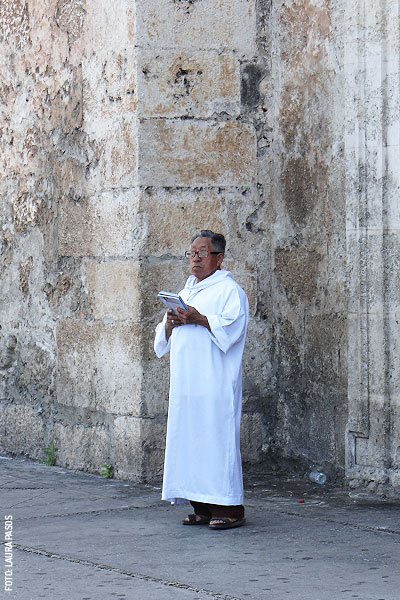 Monday to Saturday
Monday to Saturday
- 8:15 am
- 10 am
- 11:15 am
- 6:30 pm
Sundays
- 8 am
- 10 am
- 11:15 am
- 12:30 pm
- 5:15 pm
- 6:30 pm
Confessions at the Holy Metropolitan Cathedral of Mérida
Monday to Saturday
- 8 - 11:30 am
San Ildefonso Cathedral
Calle 60 x 61 y 63, Centro
Facing the Plaza Grande
Sources
- Historia de la Catedral de Mérida
- Instituto Nacional de Antropología e Historia
- Mérida en la historia
- El Cristo de la Unidad en Mérida, Yucatán: El Crucifijo tallado en madera más grande del mundo, recuperado de ramonlapayese.com
- Revista Bicentenario
- Yucatán en el Tiempo
- Yucatán Ancestral
First published in Yucatán Today print and digital magazine no. 453, in September 2025.
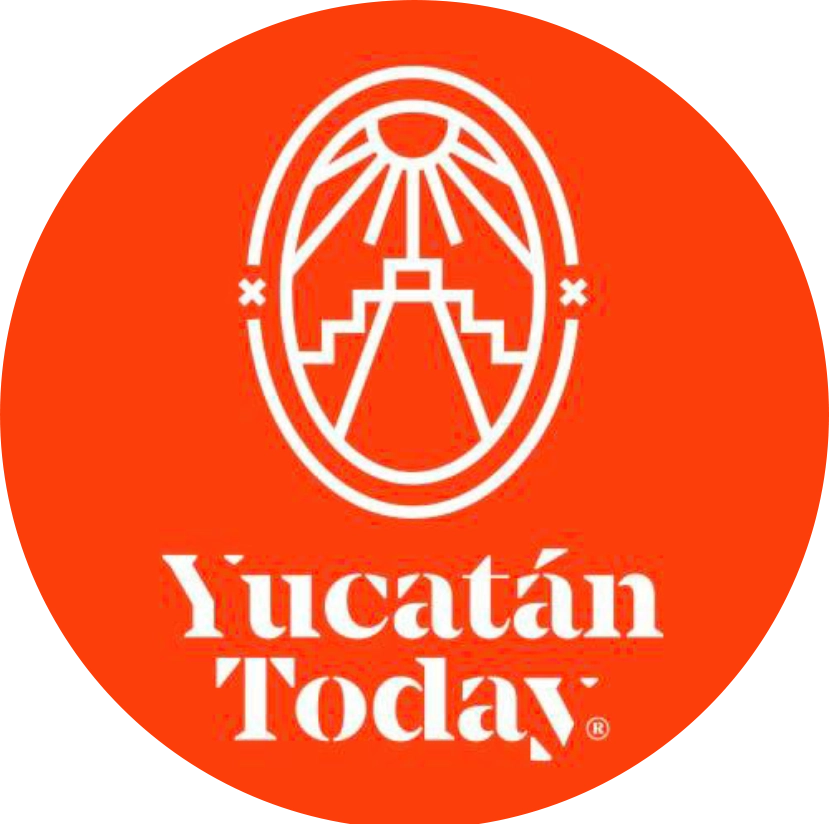
Author: Yucatán Today
Yucatán Today, the traveler's companion, has been covering Yucatán’s destinations, culture, gastronomy, and things to do for 38 years. Available in English and Spanish, it’s been featured in countless travel guides due to the quality of its content.
¡Receive the latest articles and much more from the best of Yucatán in your email!
Related articles
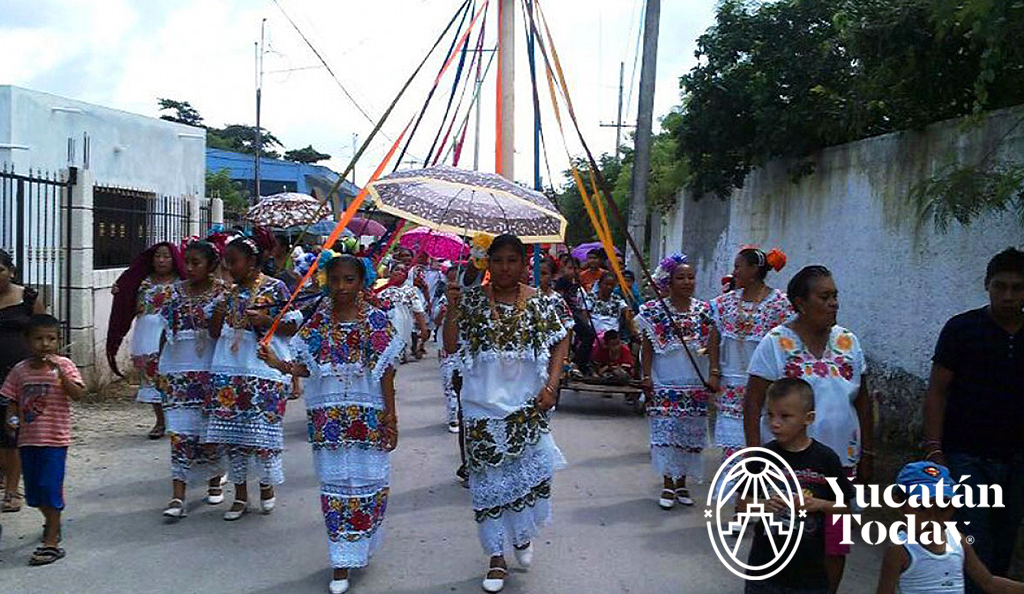
Walk along the Gremios of Mérida
Discover the colorful religious processions of Los Gremios in Mérida, a sacred tradition where locals pay homage to their professions through parades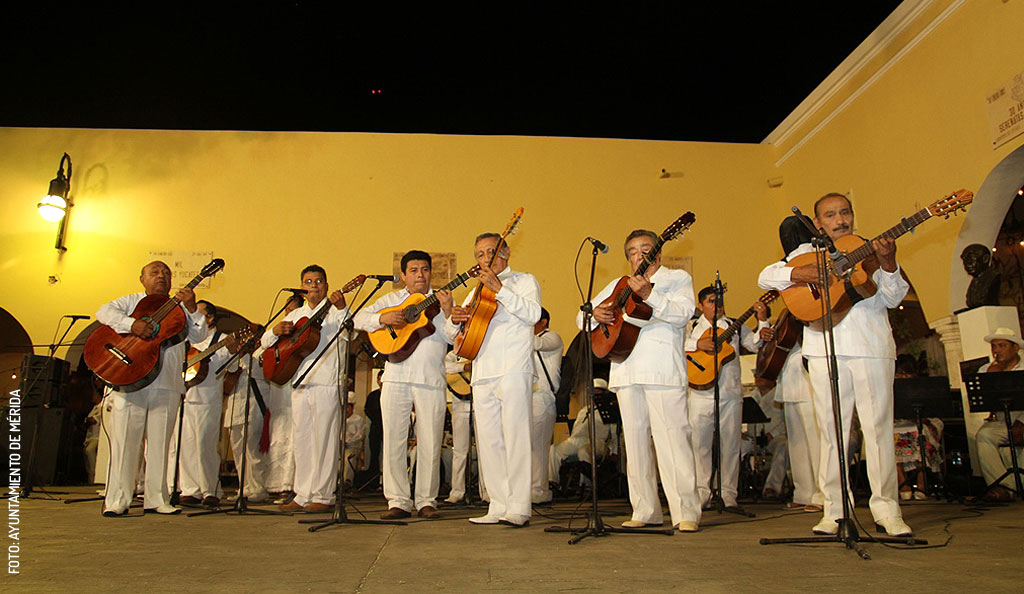
The Barrios in Mérida’s Centro
The center back then was, basically, the Plaza Grande, or main square, and everything around it, Mérida's Barrios or neighborhoods.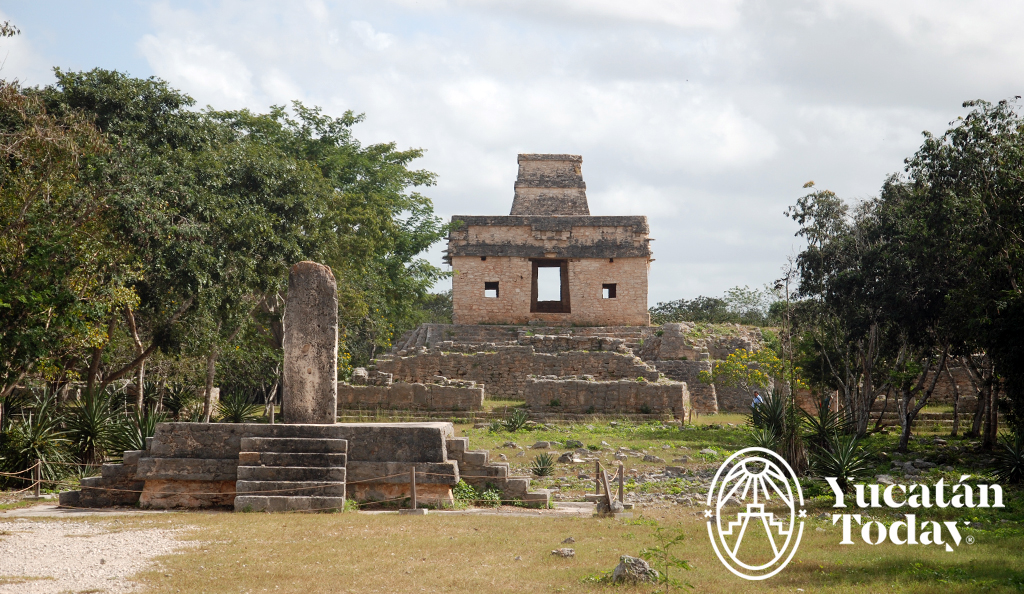



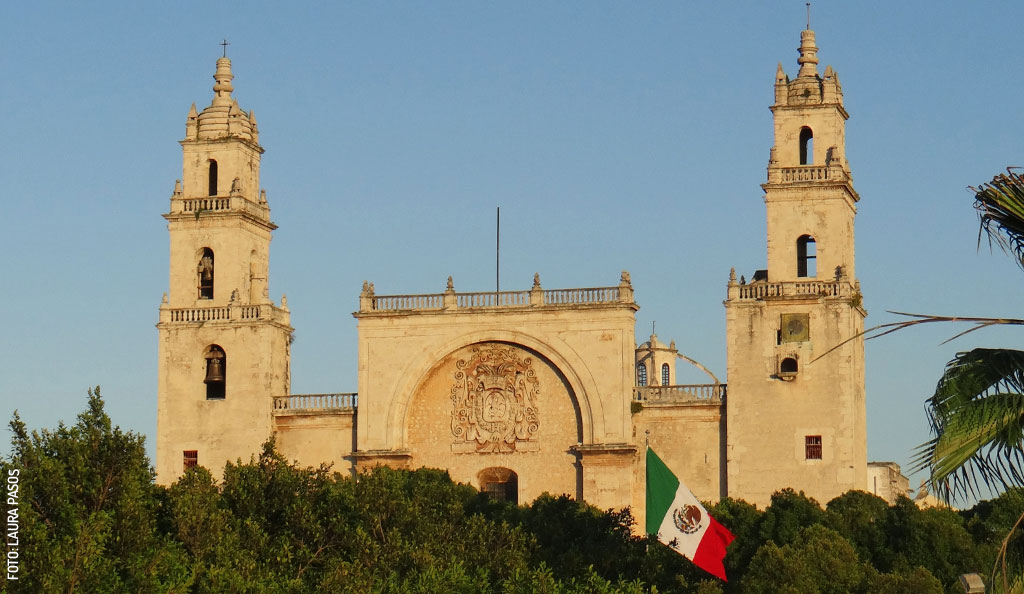
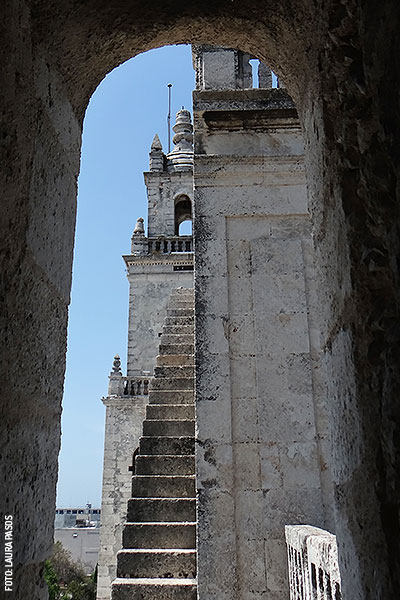 The cathedral’s destruction
The cathedral’s destruction
